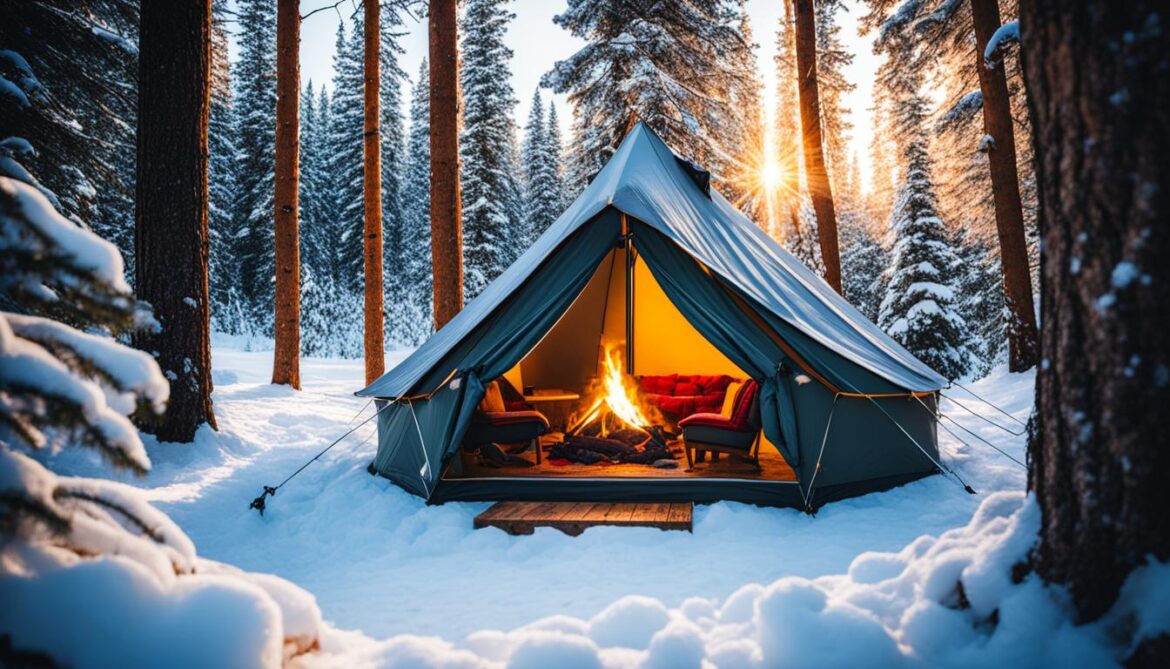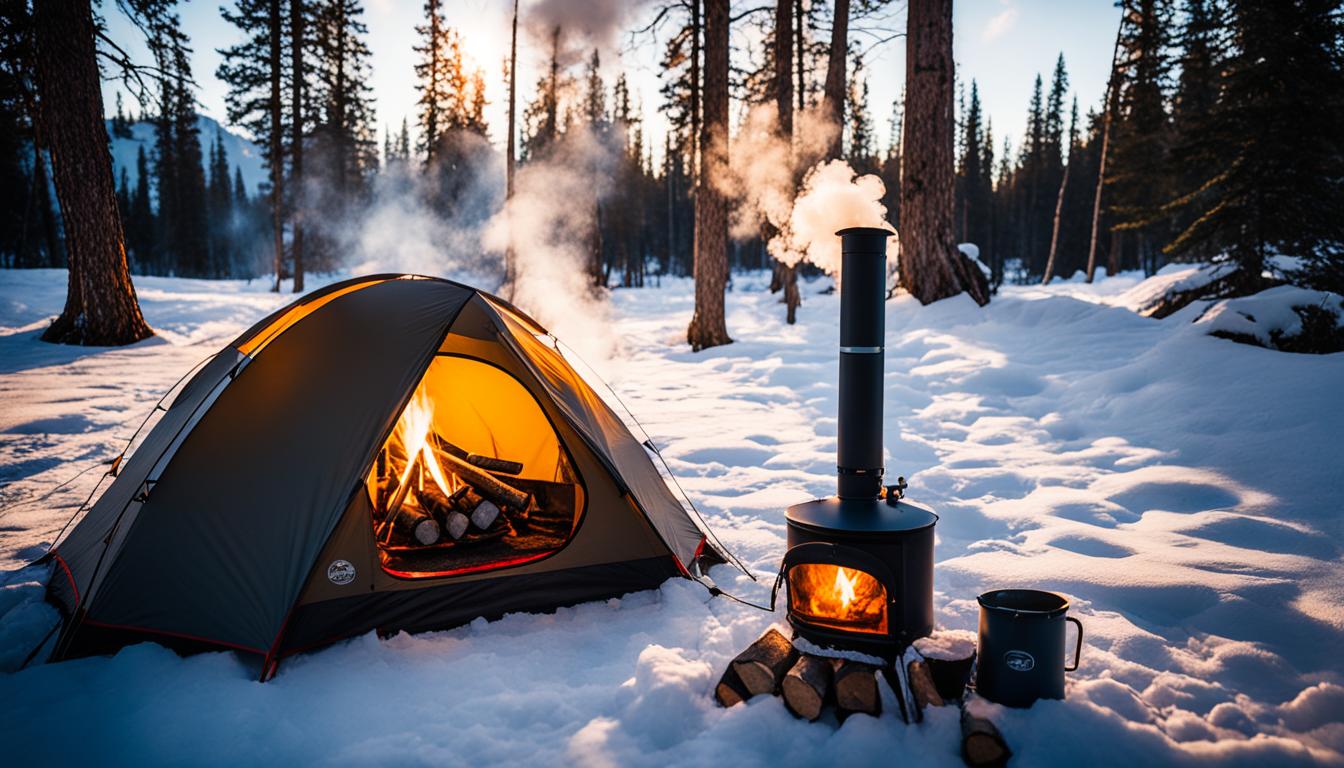In this section, we will explore various methods and tips on how to effectively heat a tent while camping. Stay warm and cozy in your camping tent with these practical techniques.
When embarking on a camping adventure, staying warm is essential for a comfortable experience. Whether you’re camping in the winter or during cooler seasons, having a well-heated tent ensures a cozy retreat from the elements. Discover the best ways to heat your tent and create a warm sanctuary amidst nature’s beauty.
Keep reading to learn valuable insights on tent insulation, preparation, and heating methods that will help you stay warm and comfortable while camping.
Tips for Insulation and Preparation
Before you can effectively heat your tent, it’s crucial to take the necessary steps to insulate and prepare it for colder temperatures. Proper tent insulation, along with suitable sleeping gear and clothing, and a well-set campsite, can make all the difference in keeping you warm and comfortable during your camping trip.
Insulating Your Tent
Insulating your tent helps retain heat and prevent cold drafts from seeping in. Here are a few tips to ensure your tent is properly insulated:
- Invest in a four-season tent that offers better insulation and weather resistance.
- Consider using a tent footprint or a layer of waterproof material below your tent to provide an extra barrier against the cold ground.
- Seal any gaps or openings in your tent using weatherstrips, duct tape, or rope. This helps minimize drafts and cold air infiltration.
- Cover the tent’s rainfly with a thermal blanket or emergency blanket to add an extra layer of insulation.
By implementing these insulation techniques, you can create a warmer and more comfortable sleeping environment inside your tent.
Choosing the Right Sleeping Gear and Clothing
Having appropriate sleeping gear and clothing plays a significant role in keeping warm inside your tent. Here are a few tips to consider:
- Use a high-quality sleeping bag designed for colder temperatures and insulation.
- Layer your sleeping bag with a liner or blankets for added warmth.
- Dress in multiple layers of clothing, including thermal underwear, wool socks, and a beanie, to retain body heat.
- Invest in a good-quality sleeping pad or mattress to provide insulation from the cold ground.
By following these tips, you can enhance your sleep quality and stay warm throughout the night.
Setting up a Suitable Campsite
The location and setup of your campsite can significantly impact your tent’s insulation and overall warmth. Consider the following:
- Choose a sheltered area away from strong winds and open spaces.
- Position your tent facing the morning sun to benefit from its warming rays.
- Clear the ground from rocks, debris, and wet areas that could make your tent colder.
- Select a spot with natural wind barriers like trees or bushes.
These steps will help create a more favorable campsite environment that promotes warmth and comfort.

With these insulation and preparation tips in mind, you’re now equipped to make your tent a cozy haven even in colder temperatures. In the next section, we’ll delve into various heating methods to further enhance your camping experience.
Heating Methods for Tents
Now that your tent is well-prepared for colder temperatures, let’s explore various heating methods that can keep you warm and comfortable during chilly nights. Whether you’re camping in the mountains or enjoying a winter camping adventure, these safe and practical heating options will ensure you stay cozy in your tent.
Portable heaters are a popular choice for heating tents. These compact devices provide instant warmth and are easy to carry and operate. Look for propane-powered heaters that are specifically designed for outdoor use, ensuring proper ventilation to reduce the risk of carbon monoxide build-up. Remember to follow the manufacturer’s instructions and never leave the heater unattended.
Another effective heating option is camping stoves. Not only do they serve as a cooking appliance, but they also generate heat that can warm up your tent. Opt for a stove that is suitable for indoor use, equipped with a safety shut-off valve and a flame diffuser to prevent accidental fires. Always place the stove on a stable surface away from any flammable materials.
In addition to portable heaters and camping stoves, there are heating equipment specifically designed for tents. These devices offer a safe and efficient way to heat your tent, often featuring built-in safety features such as automatic shut-off and flameless operation. Look for reliable brands like Coleman, Mr. Heater, or Dometic for quality tent heating solutions.
If you prefer alternative heating methods, consider using hot water bottles or electric blankets. Hot water bottles filled with warm water can be placed inside your sleeping bag or under the blankets to provide localized warmth. Electric blankets, powered by battery or USB, offer a cozy and energy-efficient option to keep you comfortable throughout the night.
With these tent heating methods, you can ensure a warm and enjoyable camping experience even in colder weather conditions. Remember to prioritize safety, follow the manufacturer’s instructions, and always keep a close eye on the heating devices to prevent any accidents. Stay cozy and embrace the beauty of the great outdoors!

